MDL Leads the Way in Providing Wet Bulb Globe Temperature Forecasts to the Public - MDL
Jun 24, 2021
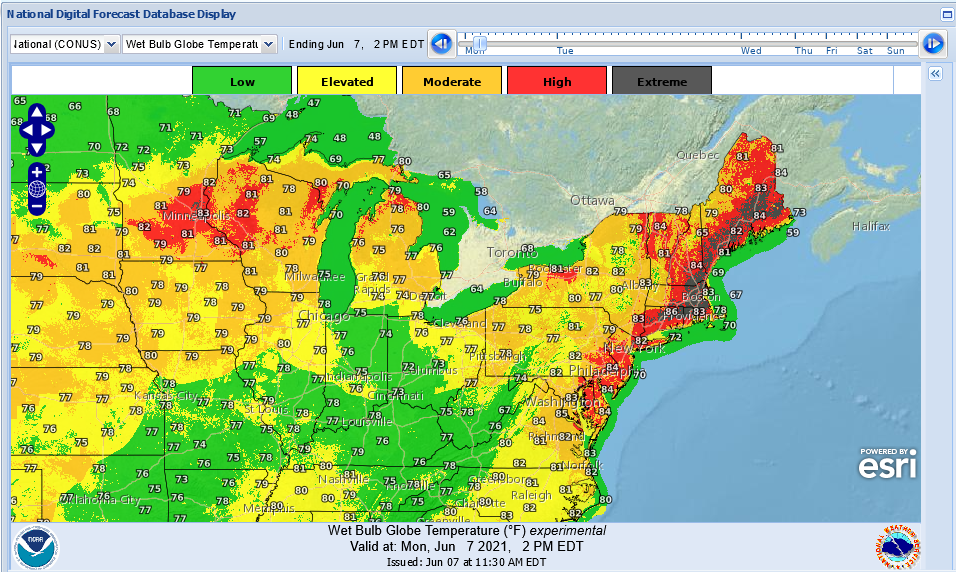
Now that warmer weather is again upon us, “fans” of MDL and its products will take comfort in knowing that we have been working diligently to bring groundbreaking, new heat-related forecast guidance to the NWS and general public. Over the past couple of years, scientists in MDL’s Digital Forecast Services Division (DFSD) have collaborated with other field experts in the development of a new software application to calculate the Wet Bulb Globe Temperature, or WBGT, from other parameters within the National Digital Forecast Database (NDFD). Early this year, the current operational version was implemented on the NDFD central server. This work is being expanded by the Statistical Modeling Division (SMD) to utilize the new NDFD algorithm in generating forecasts of WBGT from the suite of Numerical Weather Prediction (NWP) models used as input to the National Blend of Models (NBM). This will enable MDL to generate objective, bias-corrected forecasts of WBGT, adding this information to the set of other heat-related parameters already included in the Blend.
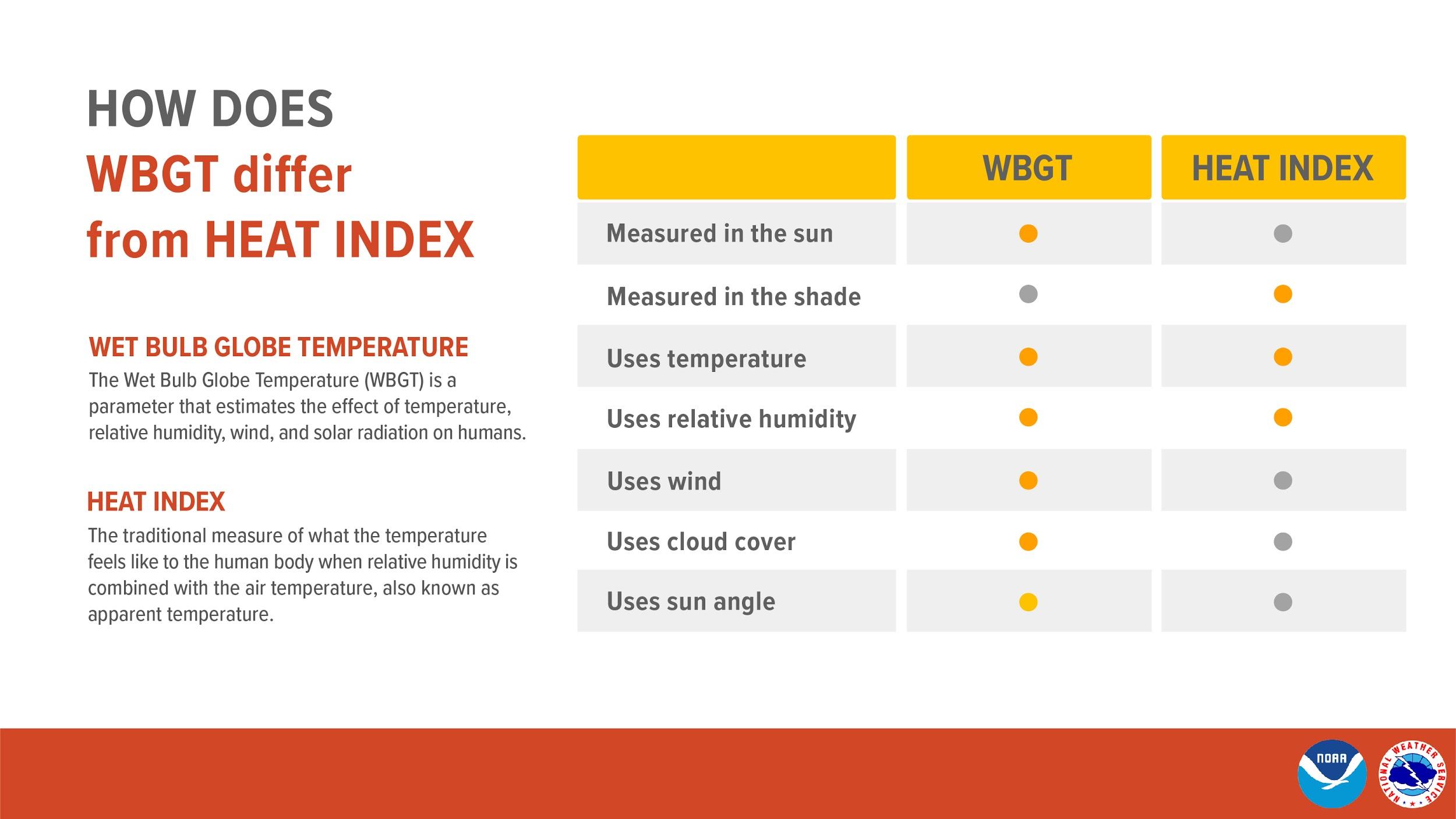
The WBGT is a relatively new parameter that is rapidly gaining acceptance among those concerned with ensuring the safety of persons subject to heat stress due to prolonged work or other strenuous outdoor activities during warm weather. Though similar to the more commonly-used apparent temperature (also known as the heat index), the WBGT also factors in the effects of solar radiation and wind on the human body (which the apparent temperature does not). In fact, studies have shown high values of WBGT to be more directly correlated with heat-related emergency room visits than those of apparent temperature. WBGT values are a combination of the dry-bulb (ambient) air temperature, wet-bulb temperature, and the black globe temperature (which measures effective incoming solar radiation). Specifically, WBGT = 0.7Tw + 0.2Tg + 0.1Td, where Tw, Tg, and Td are the observed wet-bulb, black globe, and ambient dry-bulb temperatures, respectively.
The history of WBGT forecasts in the NDFD dates back to April, 2019 when MDL was asked by the NWS Analyze, Forecast and Support Office (AFS) to look into generating WBGT forecasts for the CONUS from forecast data being sent to the NDFD by WFOs. This requirement was soon expanded to include the domains of Puerto Rico, Hawaii, and Guam. Some offices (e.g., WFO Tulsa [TSA]) had already been generating WBGT locally and posting images, or supporting web-based tools to compute WBGT. However, this was the first initiative to generate national forecast grids of WBGT.
NDFD forecasts of WBGT use as input high-resolution (temporal and spatial) grids of temperature, dew point, wind speed and sky cover, all elements for which NDFD had been issuing forecasts for years. In addition to the NDFD sensible weather elements, calculation of WBGT uses estimates of incoming solar radiation (in W/M2). This requires computing the solar flux at each NDFD grid point at hourly temporal resolution. Additional data needed to produce forecasts of WBGT include atmospheric pressure at each NDFD grid point (calculated as station pressure from NBM MSLP guidance and grid point elevation), high-resolution surface albedo (obtained from the NOAA17 AVHRR3 dataset) and estimates of surface roughness. Surface roughness is needed to reduce NDFD 10m wind speeds to 2m, using the log law as applied to boundary layer flow. Surface roughness was derived from USGS MODIS-based land use data.
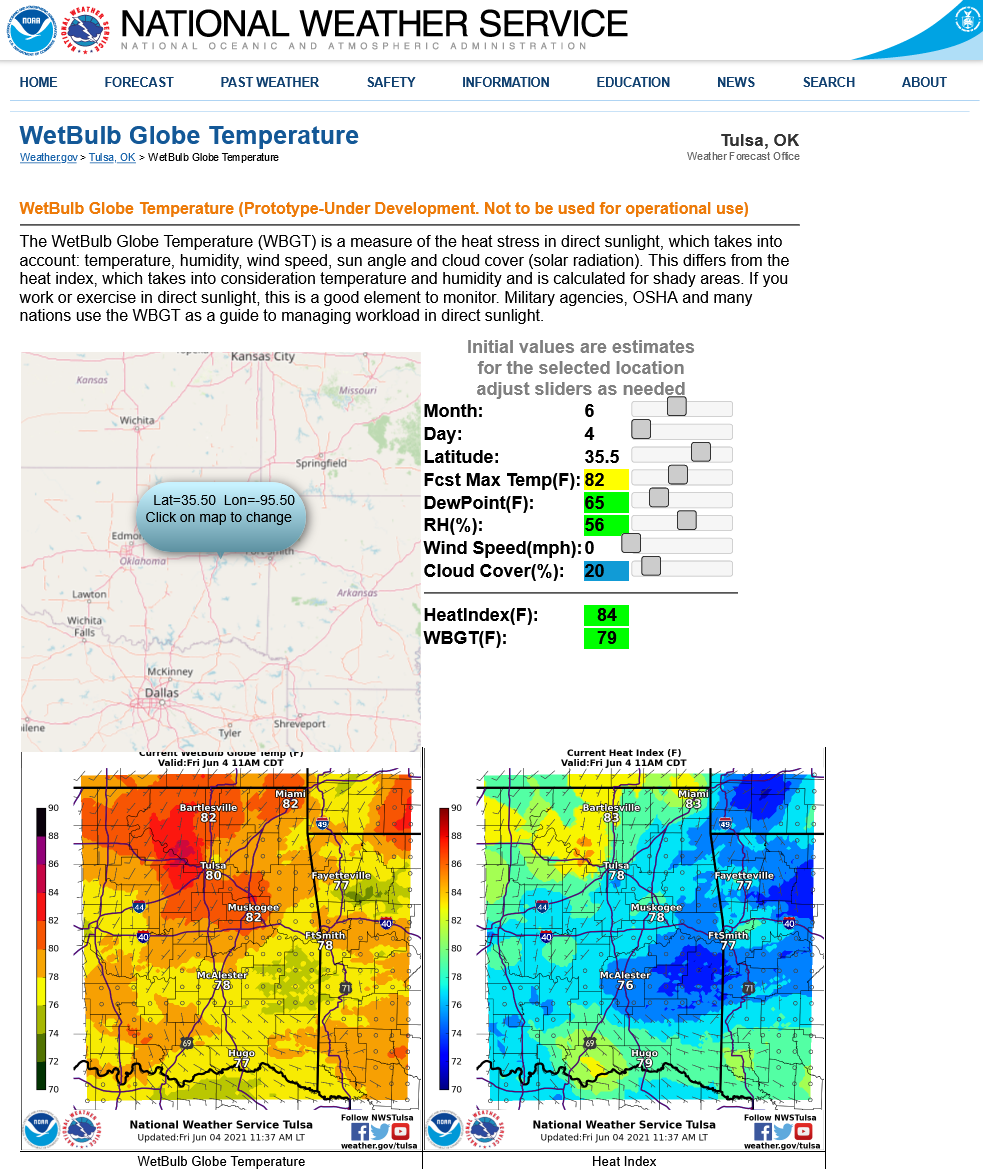
The initial version of the NDFD software was based on the Graphical Forecast Editor (GFE) smart tool written at WFO Tulsa (TSA), which employs the Dimiceli method (Dimiceli et al., 2013) for computing black globe temperature. Adapting the TSA code for NDFD presented a number of challenges, most of which centered around transforming an application intended for calculating daily maximum WBGT values over a very limited domain into one which could calculate hourly forecast values anywhere on the NDFD grids. Namely, a number of the solar flux variables which could be treated as constants in the TSA code (e.g. sunrise/sunset time, solar noon and zenith angle) now required explicit calculation at each NDFD gridpoint. Additionally, the TSA code was written in Python and relied upon various support functions embedded in the GFE smart tool environment. These functions and other needed APIs do not exist in the NDFD software, and the Python code was re-written in C++, which is the predominant programming language used in the NDFD. Tim Boyer of DFSD took the lead in this effort.
During this initial experimental period, the source code for NDFD WBGT was requested by and sent to several interested parties. Blaine Thomas, a meteorologist at the US Army White Sands Missile Range, provided valuable feedback, identified some errors in the original TSA algorithms, and made suggestions to improve WBGT forecast accuracy, most of which were incorporated into the NDFD code. These included altering the percentages of direct beam versus diffuse beam solar radiation based on sky cover, as well as using real-world albedo values at each NDFD grid point (TSA assumed a constant albedo of 0.2). The updated software was installed on the NDFD central server in spring 2020.
The spring 2020 version of NDFD WBGT gained a lot of attention, notably as a part of the Wet Bulb Globe Temperature and Heat Webinar hosted by AFS in May 2020. The webinar was attended by over 70 field office and NWS HQ personnel, and presenters emphasized the usefulness of WBGT as better tool for warning the public of the dangers of heat stress. Of particular importance to attendees were NWS plans to use NDFD WBGT as a way to communicate this information to the public.
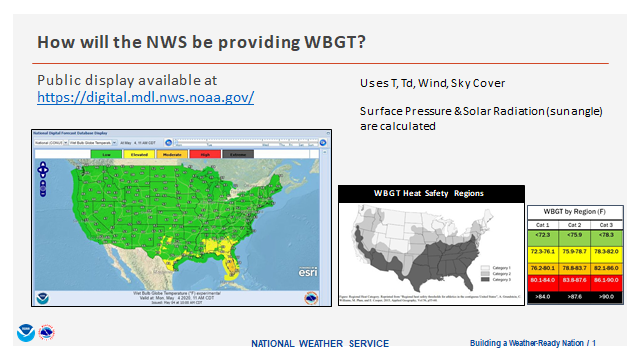
The NWS webinar served to enhance field interest in the NDFD WBGT algorithm and soon led to additional suggestions for improvement from Blaine Thomas and our White Sands partners. Among these were adjustments to the heat transfer coefficient to better match observed values of black globe temperature and an algorithm to modify the maximum total incoming solar radiation based on sky cover. Perhaps the most important modification suggested by White Sands was to reduce the NDFD 10m wind speeds to 2m, the height at which WBGT observations are taken. The 10m winds, which are almost always greater in magnitude than those observed at 2m, tended to result in a cold bias in WBGT forecast values. Due to evaporative cooling effects on the human body, higher wind speeds generally result in lower values of WBGT, all other factors being equal.
The current version of the WBGT application was completed in late summer 2020 and was updated on the NDFD Central Server in January 2021. Comparison of the new WBGT forecasts with output from the older version of the code show that the previously-observed cold bias has been reduced (most likely due to the use of 2m wind speeds). The adjustments to the heat transfer coefficient also appear to produce more realistic WBGT values in the nighttime hours. The input and analysis from White Sands played a large role in the diagnosis of these issues and in improving the final result. According to Tim, “Mr. Thomas' valuable input and expertise have been critical to the improvement of the NDFD WBGT software."
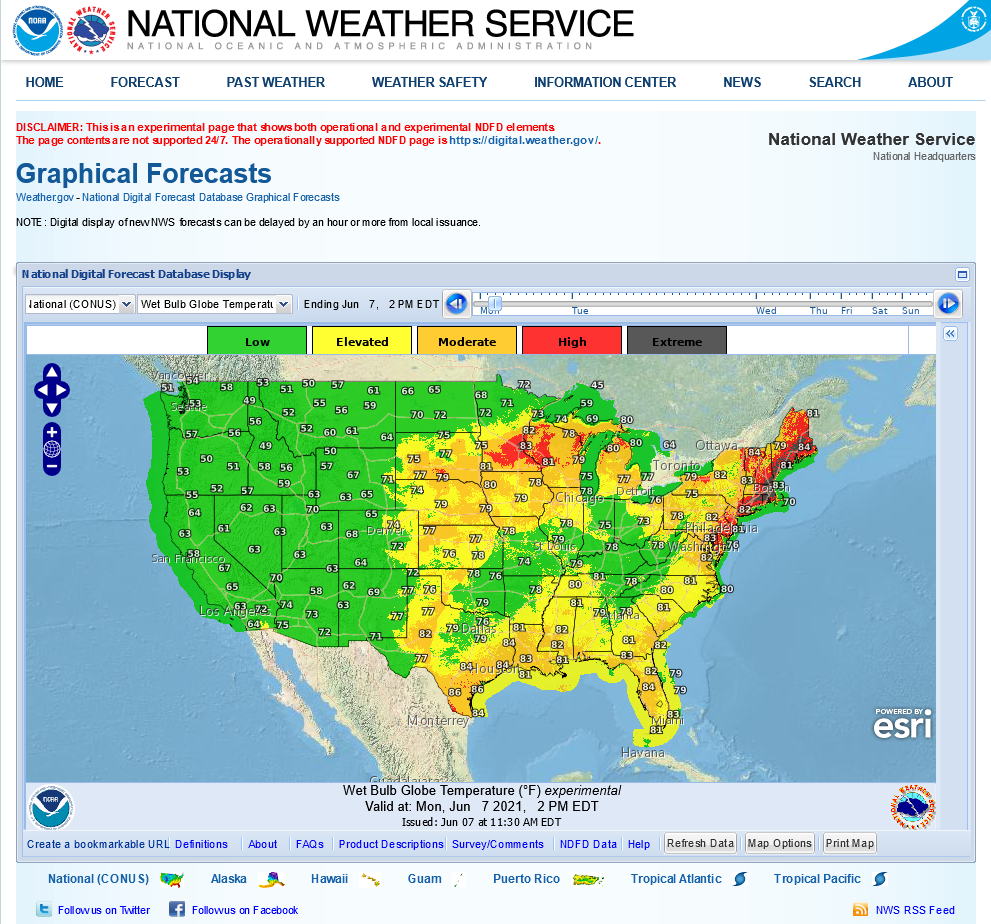
An MDL VLab repository has been specifically created for sharing the NDFD WBGT software with other developers, and work already is underway to integrate the latest version into the NBM. Not only is the NBM team drawing heavily upon that repo, but there are others outside of MDL also working with the code, including an effort (initiated by AFS) to reconvert the software back into Python for use in the GFE at the WFOs. The goal of this external effort is to be able to create WBGT forecasts on local WFO grids which are consistent with the improved algorithms now used in NDFD and which are being incorporated into the NBM.
The NBM work will center around transforming the NDFD code into a format which can work together with the NBM routines that ingest and operate on NWP model data and produce operational Blend products on NCEP supercomputers, including a further “retranslation” of many of the NDFD C++ routines into Fortran. Carly Buxton, Eric Engle, and Dave Rudack of SMD are working with Tim on this effort. NBM WBGT output likely will be very similar to what is currently available in NDFD--and similar to current NBM apparent temperature fields--with grids available for the CONUS, Hawaii, Puerto Rico, and Guam. Solar radiation inputs and calculations also will be handled in much the same way as in NDFD, with perhaps some slight changes to the input geophysical datasets in order to accommodate the broader NBM domains. The main difference is that, in lieu of the forecaster-generated fields used in the NDFD application, calculation of NBM WBGT will utilize the bias-corrected, Mean Absolute Error (MAE)-weighted inputs of NBM temperature, dew point, sky cover, and wind speed as derived from the NWP model forecasts which feed the Blend.
The NBM version of the WBGT algorithm should be complete and running experimentally by the end of this year, with the new WBGT fields to be included as part of NBM v4.1. NBM v4.1 itself is currently scheduled for operational implementation early in 2023, contingent upon the completion of NCEP’s migration to a new generation of supercomputers. While the timetable for the eventual production of the final, operational WBGT products may still be a bit “up in the air,” so to speak, one thing is for certain, though: when the heat is on, the public can always look to the NWS and MDL for cutting-edge weather safety information and forecasts.